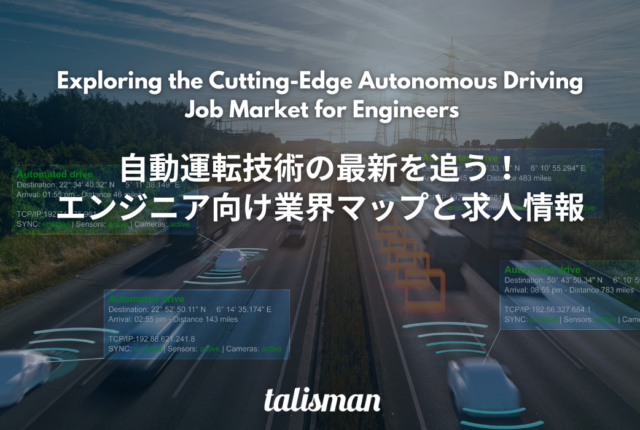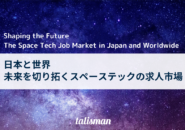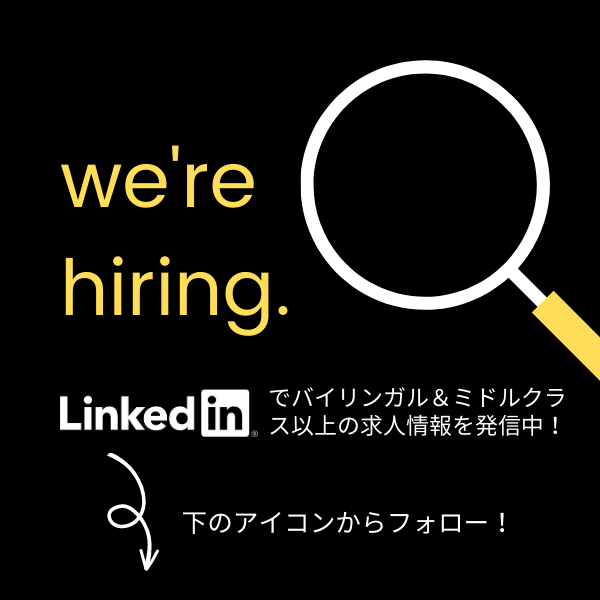Autonomous driving technology has great potential to solve social issues, such as reducing traffic accidents, easing traffic congestion, making travel more efficient, and reducing environmental problems. At the same time, this technology is forming a new industrial ecosystem involving not only automobile manufacturers but also various industries such as IT companies, communication companies, semiconductors, and battery manufacturers. As a result, there is a growing demand for people with expertise and experience related to autonomous driving technology, and new career opportunities are being created in a wide range of occupations, including software development engineers, AI development engineers, sensor engineers, data analysts, and even project managers.
In this article, we will explore in detail the latest trends in autonomous driving technology in the automotive industry and the associated changes in the job market. From the cutting edge of technology to the possibility of career changes, we will explore the full scope of new opportunities brought by autonomous driving.
-
Hello! I am KF, an Auto tech consultant at Talisman Corporation, who will guide you through this content.
I usually help people change jobs to the autonomous driving and MaaS industries, so I would be happy if you could use this page as a reference and ask me for advice. AutoTechTeam
AutoTechTeam
K.F
目次
The Automotive Industry: A Transformation in a Century
Electrification and the development of autonomous driving technology
In 2023, global car sales reached 92.72 million units (*1), with the total market size of the automotive industry estimated at approximately ¥400 trillion, making it the largest industry globally. Over the past few decades, the industry has undergone significant technological advancements. Recently, the concept of “CASE” (Connected, Autonomous/Automated, Shared & Services, and Electrification) has gained significant attention, heralding a transformation that the industry describes as a “once-in-a-century revolution.”
Electric Vehicle (EV) sales have been steadily increasing. According to projections by the International Energy Agency (IEA), approximately 17 million EVs are expected to be sold in 2024, accounting for 20% of global new car sales (*2). This shift is crucial for achieving carbon neutrality, which aims to balance greenhouse gas emissions with their absorption.
Autonomous driving technology is also considered a cornerstone of the automotive industry’s future. It is highly anticipated for its potential to prevent accidents, improve traffic efficiency, and address labor shortages. Automotive manufacturers are focusing on developing sustainable transportation systems and offering innovative mobility services, driving the industry’s continued evolution.
(Source)
※1 OICA(国際自動車工業連合会)「Global Sales Statistics 2019 – 2023」
※2 IEA(国際エネルギー機関)Global EV Outlook 2024
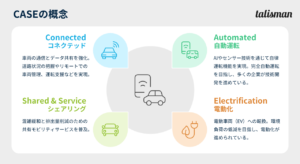
Levels of Autonomous Driving and Key Technologies
Autonomous driving is classified into six levels, ranging from Level 0 (manual driving) to Level 5 (full automation). In Japan, Level 2 and Level 3 technologies have been commercialized. These technologies partially automate driving under specific conditions, allowing drivers to relinquish control in certain scenarios. For example, at Level 3, autonomous driving on highways is possible, enabling hands-off operations under defined conditions.
| Levels of Autonomous Driving | Driving Entity | Overview |
|---|---|---|
| 0 – No driving automation | Driver | The driver is responsible for all driving tasks. Traditional vehicles without ADAS (Advanced Driver Assistance Systems) |
| 1 – Driver assistance | Driver | The system controls the vehicle either forward/backward or left/right (either accelerator/brake operation or steering operation is partially automated). Examples include automatic braking, following the vehicle in front (ACC: Adaptive Cruise Control), and staying within the lane (LKAS: Lane Keep Assist System). |
| 2 – Partially automated driving | Driver | The system performs the dynamic driving task of controlling vehicle motion in both longitudinal and lateral directions (accelerating, braking and steering) within a limited area. |
| 3 – Conditional Driving Automation | system | The system performs all driving tasks under certain conditions. During autonomous driving, the system takes over as the driver, but the driver must respond appropriately to requests for intervention from the system. |
| 4 – Highly automated driving | system | The system performs all driving tasks, and responds to situations where it is difficult to continue operation in a limited area. |
| 5 – Fully autonomous | system | The system constantly performs all driving tasks and takes over all driving operations. |
For a car to drive autonomously, it must replicate three critical human actions: perception, decision-making, and control. Below, we highlight some of the key technologies enabling autonomous driving.
| Cognition | LiDAR | This technology allows vehicles to detect surrounding objects and terrain with high accuracy. It measures the time it takes for laser light to hit an object and bounce back, and is used to measure the distance and direction to an object and identify other vehicles and obstacles. |
|---|---|---|
| Cognition | HD Maps | High-precision 3D map data is essential for autonomous vehicles to determine their exact position down to the centimeter, and to make decisions based on traffic rules and terrain. |
| Judgment | AI (Artificial Intelligence) | AI technology plays a vital role in enabling autonomous vehicles to recognize their environment and make decisions. Deep learning and data analysis allow vehicles to understand their surroundings and make optimal driving decisions. |
| operation | Software Development | Software is the core component that enables safe driving of a vehicle. It is the program that processes the data obtained from each sensor and controls the movement of the vehicle. |
Trends in autonomous driving in each country (technological trends and regulations) *2025/4/10 updated
With the advancement of autonomous driving technology, countries and companies around the world are competing in its development, while regulatory frameworks are also being established in parallel. The simultaneous evolution of electrification and autonomous driving is contributing to the provision of cleaner transportation and more efficient traffic infrastructure. In the market, transformative impacts are expected across various sectors, including reductions in traffic accidents, greater efficiency in logistics, and the reconstruction of urban transportation systems.
- USA
Companies like Waymo and Cruise are conducting trials and deploying Level 3 to Level 4 autonomous driving technologies. In particular, Waymo, a subsidiary of Alphabet, began offering Level 4 autonomous taxi services to the public in parts of Los Angeles starting in November 2024, following services in San Francisco, California, and Phoenix, Arizona. They plan to gradually expand these service areas. In October 2024, Tesla unveiled a prototype of an EV taxi featuring Level 4 autonomous driving, with plans to offer it for under $30,000 (approximately 4.5 million yen). Production is scheduled to begin in 2026. Additionally, Tesla plans to launch its robotaxi service in Austin, Texas in June 2025, with expansion to other cities later in the year. - China
Autonomous driving services are becoming more integrated in China compared to other countries. Companies like WeRide and tech giant Baidu are operating Level 4 robotaxi services. These companies have also obtained operational licenses outside China and plan to launch services in the U.S., UAE, Singapore, France, and other countries. A new regulation implemented in Beijing in April 2025 allows privately owned vehicles with Level 3 or higher autonomous driving to operate on public roads, which is expected to further accelerate innovation and product development. - Japan
Toyota and Honda are actively developing autonomous driving technologies. Toyota is aiming to implement commercial operations of autonomous vehicles in urban areas as part of its vision for MaaS (Mobility as a Service). Honda has established itself as a technological leader in Japan by releasing the world’s first mass-produced vehicle equipped with Level 3 autonomous driving technology, the Legend.
Regarding autonomous taxis, Waymo announced a partnership with Nihon Kotsu and GO to begin autonomous vehicle trials in Tokyo in early 2025 as part of an international road trip initiative.
Additionally, some municipalities have already started operating buses with Level 2 to 4 technologies, raising hopes that this can help alleviate the bus driver shortages currently affecting many companies.
From autumn 2025, Toyota plans to begin pilot testing in Woven City, currently under construction in Susono City, Shizuoka Prefecture. This “living laboratory” integrates autonomous driving, AI, robotics, and renewable energy. The first phase will involve approximately 360 residents, and the project is attracting significant attention.
Progress in Autonomous Driving and Safety Concerns
On March 29, 2025, a tragic accident involving Xiaomi’s electric vehicle “SU7” in Anhui Province, China, resulted in the deaths of three university students. This incident has reignited discussions around the safety of driver-assistance systems. Although the vehicle issued a warning after detecting an obstacle while operating in smart assist mode on a highway, it failed to avoid a collision.
Similar fatal accidents have occurred in the United States in the past. While autonomous driving offers convenience and efficiency, it also raises safety and ethical issues. These incidents highlight that autonomous driving technology is still in a developmental stage. Collaborative efforts among companies, regulators, and users are essential to improving safety. It is important to recognize that “technology is not meant to fully replace humans, but to complement them,” and to prioritize safety in its deployment.
Japan’s Mobility DX Strategy
As the technological development race intensifies in each country as described above, Japan formulated the “Mobility DX Strategy” in May 2024 after public-private discussions under the leadership of the Ministry of Economy, Trade and Industry. The ultimate goal of the strategy is for Japan to achieve a 30% share of global sales of SDVs (*) by 2035.
※SDV(Software Defined Vehicle):A vehicle equipped with bidirectional communication capabilities between the car and external systems, allowing software updates that enable the addition of new features and performance enhancements even after the vehicle has been sold.
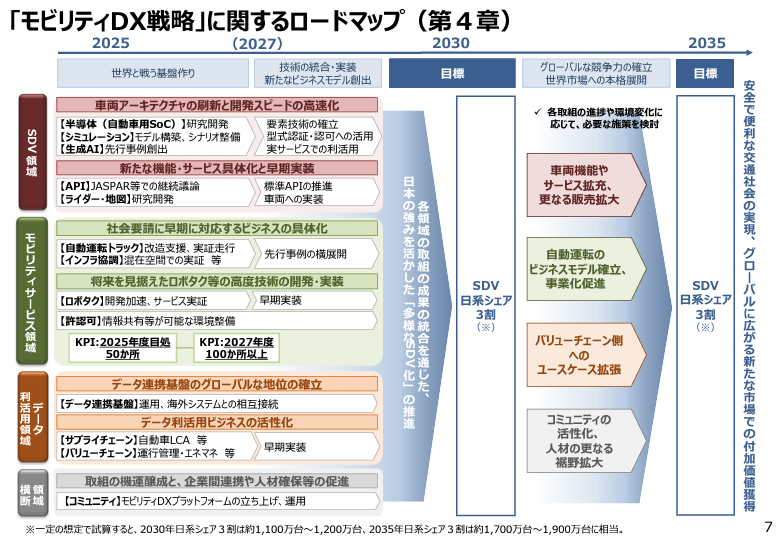
In the strategic roadmap, the government has set a KPI for the mobility services sector of realizing transportation services utilizing Level 4 autonomous driving systems in around 50 locations nationwide by fiscal 2025, and at more than 100 locations by fiscal 2027. In addition, measures are included to secure software engineering talent, and there is a strong recognition of the challenges in terms of human resources , with plans to launch a community called the “Mobility DX Platform.”
The Autonomous Driving and MaaS Industry Map
The image is an industry map created by the 35ish editorial department that lists notable autonomous driving and MaaS companies by segment.
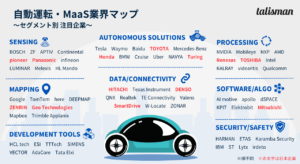
Of course, the major automobile and semiconductor manufacturers are the most obvious Japanese companies (shown in bold red), but below we will introduce some particularly noteworthy startup companies.
- Turing Co., Ltd.
Although Turing was founded in August 2021, it has been promoting itself as an “automobile manufacturer” from the beginning. CEO Yamamoto stated that “we will create a finished car manufacturer that will surpass Tesla,” and has set its mission as “We Overtake Tesla.” Another noteworthy point is that the company has set a goal of mass-producing 10,000 fully autonomous EVs by 2030. - SmartDrive Co., Ltd.
(since 2013) has set the vision of “supporting the evolution of mobility” since its founding, and collects and analyzes various sensor data related to moving objects and deploys it on an open platform. It has a track record of implementation and partnerships with many large companies, and was listed on the Tokyo Stock Exchange Growth Market in December 2022.
Below is a list of noteworthy companies related to autonomous driving technology. You can also search by category, so please use it to gather information.
*Created by the 35ish editorial department based on the client list (including candidates) of the Talisman AutoTech specialist team.
| 分類 | 企業名 / Website | 国 |
|---|---|---|
| AUTONOMOUS SOLUTIONS | Audi | |
| AUTONOMOUS SOLUTIONS | Ford | |
| AUTONOMOUS SOLUTIONS | Hyundai | |
| AUTONOMOUS SOLUTIONS | KIA motors | |
| AUTONOMOUS SOLUTIONS | Stellantis | |
| AUTONOMOUS SOLUTIONS | Volkswagen | |
| AUTONOMOUS SOLUTIONS | Toyota | |
| AUTONOMOUS SOLUTIONS | Nissan | |
| AUTONOMOUS SOLUTIONS | BAIC | |
| AUTONOMOUS SOLUTIONS | Mercedes-Benz | |
| AUTONOMOUS SOLUTIONS | BMW | |
| AUTONOMOUS SOLUTIONS | GM | |
| AUTONOMOUS SOLUTIONS | Honda | |
| AUTONOMOUS SOLUTIONS | Jaguar | |
| AUTONOMOUS SOLUTIONS | GEELY | |
| AUTONOMOUS SOLUTIONS | Renault | |
| AUTONOMOUS SOLUTIONS | Tesla | |
| AUTONOMOUS SOLUTIONS | Volvo | |
| AUTONOMOUS SOLUTIONS | SAIC | |
| AUTONOMOUS SOLUTIONS | CHANGAN | |
| AUTONOMOUS SOLUTIONS | CHERY | |
| AUTONOMOUS SOLUTIONS | Waymo | |
| AUTONOMOUS SOLUTIONS | LYFT | |
| AUTONOMOUS SOLUTIONS | NAVYA | |
| AUTONOMOUS SOLUTIONS | Torc Robotics | |
| AUTONOMOUS SOLUTIONS | SD advanced engineering | |
| AUTONOMOUS SOLUTIONS | Uber | |
| AUTONOMOUS SOLUTIONS | Easy mile | |
| AUTONOMOUS SOLUTIONS | 2get there | |
| AUTONOMOUS SOLUTIONS | Baidu 百度 | |
| AUTONOMOUS SOLUTIONS | Zoox | |
| AUTONOMOUS SOLUTIONS | Nauto | |
| AUTONOMOUS SOLUTIONS | May mobility | |
| AUTONOMOUS SOLUTIONS | NXP | |
| AUTONOMOUS SOLUTIONS | ZF | |
| AUTONOMOUS SOLUTIONS | NVIDIA | |
| AUTONOMOUS SOLUTIONS | MAGNA | |
| AUTONOMOUS SOLUTIONS | Continental | |
| AUTONOMOUS SOLUTIONS | BOSCH | |
| AUTONOMOUS SOLUTIONS | Aptiv | |
| AUTONOMOUS SOLUTIONS | HITACHI | |
| AUTONOMOUS SOLUTIONS | Renesas | |
| AUTONOMOUS SOLUTIONS | SAMSUNG | |
| AUTONOMOUS SOLUTIONS | intel | |
| AUTONOMOUS SOLUTIONS | Visteon | |
| AUTONOMOUS SOLUTIONS | ZMP | |
| AUTONOMOUS SOLUTIONS | RoboCV | |
| AUTONOMOUS SOLUTIONS | Turing | |
| PROCESSING | Renesas | |
| PROCESSING | NVIDIA | |
| PROCESSING | Mobileye | |
| PROCESSING | KALRAY | |
| PROCESSING | Synopsys | |
| PROCESSING | NXP | |
| PROCESSING | TOSHIBA | |
| PROCESSING | CEVA | |
| PROCESSING | cadence | |
| PROCESSING | Imagination Technologies | |
| PROCESSING | Analog Devices | |
| PROCESSING | AMD | |
| PROCESSING | intel | |
| PROCESSING | arm | |
| PROCESSING | Outsight | |
| PROCESSING | ST | |
| PROCESSING | videantis | |
| PROCESSING | Texas Instrument | |
| PROCESSING | MARVELL | |
| PROCESSING | Graphcore | |
| PROCESSING | Qualcomm | |
| PROCESSING | AI motive | |
| SENSING | BOSCH | |
| SENSING | Texas Instrument | |
| SENSING | ZF | |
| SENSING | Mitsubishi | |
| SENSING | Continental | |
| SENSING | microvision | |
| SENSING | Valeo | |
| SENSING | XenomatiX | |
| SENSING | arbe | |
| SENSING | TOSHIBA | |
| SENSING | HITACHI | |
| SENSING | Luminar | |
| SENSING | Autoliv | |
| SENSING | KOSTAL | |
| SENSING | HYUNDAI MOBIS | |
| SENSING | Aptiv | |
| SENSING | INNOVIZ | |
| SENSING | Pioneer | |
| SENSING | DENSO | |
| SENSING | robosense | |
| SENSING | LG Innotek | |
| SENSING | LYNRED | |
| SENSING | Panasonic | |
| SENSING | HARMAN | |
| SENSING | Denso ten | |
| SENSING | MAGNA | |
| SENSING | OUSTER | |
| SENSING | TetraVue | |
| SENSING | QUANERGY | |
| SENSING | Aeye | |
| SENSING | Teledyne FLIR | |
| SENSING | FORVIA HELLA | |
| SENSING | novatel | |
| SENSING | Infineon Technologies | |
| SENSING | ECHODYNE | |
| SENSING | HL Mando | |
| SENSING | Leddar Tech | |
| SENSING | Trimble Applanix | |
| SENSING | NXP | |
| SENSING | Trimble | |
| SENSING | U-blox | |
| SENSING | Honeywell | |
| SENSING | SBG SYSTEMS | |
| SENSING | OMNIVISION | |
| SENSING | OSRAM | |
| SENSING | SIMENS | |
| SENSING | Melexis | |
| SENSING | Lumentum | |
| SENSING | SONY | |
| DATA/CONNECTIVITY | HITACHI | |
| DATA/CONNECTIVITY | Renesas | |
| DATA/CONNECTIVITY | NXP | |
| DATA/CONNECTIVITY | Continental | |
| DATA/CONNECTIVITY | Texas Instrument | |
| DATA/CONNECTIVITY | BlackBerry QNX | |
| DATA/CONNECTIVITY | BOSCH | |
| DATA/CONNECTIVITY | MARVELL | |
| DATA/CONNECTIVITY | Analog Devices | |
| DATA/CONNECTIVITY | Semtech | |
| DATA/CONNECTIVITY | intel | |
| DATA/CONNECTIVITY | Realtek | |
| DATA/CONNECTIVITY | Cohda Wireless | |
| DATA/CONNECTIVITY | BROADCOM | |
| DATA/CONNECTIVITY | TTTech | |
| DATA/CONNECTIVITY | TE Connectivity | |
| DATA/CONNECTIVITY | Valens | |
| DATA/CONNECTIVITY | Elektrobit | |
| DATA/CONNECTIVITY | microchip | |
| DATA/CONNECTIVITY | DENSO | |
| DATA/CONNECTIVITY | HARMAN | |
| DATA/CONNECTIVITY | Infineon Technologies | |
| DATA/CONNECTIVITY | SIMENS EDA | |
| DATA/CONNECTIVITY | molex | |
| DATA/CONNECTIVITY | SmartDrive | |
| DATA/CONNECTIVITY | GreenRoad | |
| DATA/CONNECTIVITY | W-Locate | |
| DATA/CONNECTIVITY | Vnomics | |
| DATA/CONNECTIVITY | ZONAR | |
| DATA/CONNECTIVITY | Peloton Technology | |
| DATA/CONNECTIVITY | Car IQ | |
| DATA/CONNECTIVITY | IMS | |
| DATA/CONNECTIVITY | metromile | |
| DATA/CONNECTIVITY | Zubie | |
| DATA/CONNECTIVITY | Vinli | |
| DATA/CONNECTIVITY | MOJIO | |
| DATA/CONNECTIVITY | Airbiquity | |
| DATA/CONNECTIVITY | Automile | |
| MAPPING | TomTom | |
| MAPPING | here | |
| MAPPING | ||
| MAPPING | NavInfo | |
| MAPPING | Sanborn | |
| MAPPING | Dynamic Map Platform | |
| MAPPING | DEEPMAP | |
| MAPPING | GeoDigital | |
| MAPPING | Geo Technologies | |
| MAPPING | Civil Maps | |
| SOFTWARE/ALGO | Baidu 百度 | |
| SOFTWARE/ALGO | Mapbox | |
| SOFTWARE/ALGO | ZENRIN | |
| SOFTWARE/ALGO | Trimble Applanix | |
| SOFTWARE/ALGO | apollo | |
| SOFTWARE/ALGO | Elektrobit | |
| SOFTWARE/ALGO | dSPACE | |
| SOFTWARE/ALGO | NVIDIA | |
| SOFTWARE/ALGO | AI motive | |
| SOFTWARE/ALGO | Five AI | |
| SOFTWARE/ALGO | Mitsubishi | |
| SOFTWARE/ALGO | oxa | |
| SOFTWARE/ALGO | Outsight | |
| SOFTWARE/ALGO | KPIT | |
| SOFTWARE/ALGO | BASELABS | |
| SOFTWARE/ALGO | Luxoft | |
| SOFTWARE/ALGO | Neusoft | |
| SOFTWARE/ALGO | Nauto | |
| SOFTWARE/ALGO | Mobileye | |
| SOFTWARE/ALGO | HCL tech | |
| SOFTWARE/ALGO | AURORA | |
| SECURITY/SAFETY | HARMAN | |
| SECURITY/SAFETY | Karamba Security | |
| SECURITY/SAFETY | BOSCH | |
| SECURITY/SAFETY | SIMENS EDA | |
| SECURITY/SAFETY | Aptiv | |
| SECURITY/SAFETY | Continental | |
| SECURITY/SAFETY | Wind River | |
| SECURITY/SAFETY | HITACHI | |
| SECURITY/SAFETY | NXP | |
| SECURITY/SAFETY | IBM | |
| SECURITY/SAFETY | verizon | |
| SECURITY/SAFETY | Renesas | |
| SECURITY/SAFETY | PlaxidityX | |
| SECURITY/SAFETY | BlackBerry QNX | |
| SECURITY/SAFETY | intel | |
| SECURITY/SAFETY | DENSO | |
| SECURITY/SAFETY | ETAS | |
| SECURITY/SAFETY | Green Hills Software | |
| SECURITY/SAFETY | LYNX | |
| SECURITY/SAFETY | secunet | |
| SECURITY/SAFETY | irdeto | |
| SECURITY/SAFETY | Synopsys | |
| SECURITY/SAFETY | ST | |
| SECURITY/SAFETY | KPIT | |
| SECURITY/SAFETY | Rambus | |
| SECURITY/SAFETY | Texas Instrument | |
| SECURITY/SAFETY | Infineon Technologies | |
| SECURITY/SAFETY | VECTOR | |
| SECURITY/SAFETY | CAMBRIDGE MOBILE TELEMATICS | |
| SECURITY/SAFETY | Lytx | |
| DEVELOPMENT TOOLS | HCL tech | |
| DEVELOPMENT TOOLS | Ansys | |
| DEVELOPMENT TOOLS | Polysync | |
| DEVELOPMENT TOOLS | ESI | |
| DEVELOPMENT TOOLS | IAR | |
| DEVELOPMENT TOOLS | Dataspeed Inc. | |
| DEVELOPMENT TOOLS | INTEMPORA | |
| DEVELOPMENT TOOLS | LDRA | |
| DEVELOPMENT TOOLS | Mechanical Simulation | |
| DEVELOPMENT TOOLS | MathWorks | |
| DEVELOPMENT TOOLS | Synopsys | |
| DEVELOPMENT TOOLS | TTTech | |
| DEVELOPMENT TOOLS | dSPACE | |
| DEVELOPMENT TOOLS | IAV | |
| DEVELOPMENT TOOLS | ETAS | |
| DEVELOPMENT TOOLS | Elektrobit | |
| DEVELOPMENT TOOLS | AdaCore | |
| DEVELOPMENT TOOLS | KPIT | |
| DEVELOPMENT TOOLS | SIMENS | |
| DEVELOPMENT TOOLS | VECTOR | |
| DEVELOPMENT TOOLS | b-plus | |
| DEVELOPMENT TOOLS | BASELABS | |
| DEVELOPMENT TOOLS | IPG | |
| DEVELOPMENT TOOLS | SIMENS EDA | |
| DEVELOPMENT TOOLS | AMD | |
| DEVELOPMENT TOOLS | Maplesoft | |
| DEVELOPMENT TOOLS | AutonomouStuff | |
| DEVELOPMENT TOOLS | Tata Elxsi |
Current state of the automotive job market
The automotive industry is undergoing a period of great change, and the demand for IT professionals is growing rapidly. In this section, we will explain the current recruitment situation in the automotive industry and the type of people required.
Overall recruitment trends
In the automotive industry, software-related job openings are increasing rapidly. This is due to the advancement of SDV (Software Defined Vehicles), which means that software is having a major impact on vehicle functions and performance. In particular, with the spread of 5G technology, there is a growing need for hiring in the connected field, including autonomous driving systems, vehicle network connections, and OTA (Over The Air: software updates and information collection using wireless communication). This trend is also spreading to the fields of in-vehicle systems and cybersecurity, and the number of job openings has increased significantly in recent years.
Areas where job openings are on the rise
Software-related job openings are increasing in areas such as autonomous driving technology, connected systems, cybersecurity, and MaaS (Mobility as a Service) . Hiring is underway in a wide range of positions, with many job openings in the MaaS field in particular related to data analysis and mobile app development.
Systems engineers and infrastructure engineers are often hired with a focus on system development and operation skills, making these positions easy to try even for those without experience in the automotive industry. On the other hand, experience in the automotive industry is often a requirement for embedded engineers, and job changes within the industry are common. Model-based development (MBD) using simulations has become mainstream in the development of ADAS (Advanced Driver Assistance System) and AD (Autonomous Driving), and it offers various benefits such as the ability to test more situations than traditional real-vehicle testing. Therefore, engineers with model and simulation development skills are needed.
Desired personality and skills
-
Work experience rather than academic background
The automotive industry as a whole tends to emphasize work experience over academic background. In actual job postings, the job description often only states “university graduate, science major (technical)”. When changing jobs, regardless of industry, you should focus on your experience and skills from your previous job when preparing your application documents and preparing for interviews. -
A strong passion for manufacturing.
Because the automobile industry is about “manufacturing,” there are many people who have a strong passion for technology and a craftsman-like nature, especially among embedded engineers. Creativity and inquisitiveness are important factors, and an attitude of proactively learning new technologies and continuing to have a technical inquisitiveness is highly valued. - In the field of autonomous driving technology
The field of autonomous driving technology particularly welcomes individuals with the following specialized knowledge and skills:- <DAS (Driver Assistance Systems) Camera: This is a camera technology that detects the situation around the vehicle. These cameras are used in systems that assist with lane keeping, collision avoidance, traffic sign recognition, etc. People who are knowledgeable about DAS camera design and data processing are highly valued.
- AUTOSAR (AUTomotive Open System ARchitecture) : A software architecture standard widely used in the automotive industry. AUTOSAR can increase the compatibility and efficiency of in-vehicle software, so people with this knowledge are important in the development of autonomous vehicles.
- MATLAB/Simulink/Stateflow : These are tools used for modeling, simulation, and algorithm development. In autonomous driving technology, these tools are used to simulate vehicle control systems and operations, so people who are familiar with these tools are required.
- ECU (Electronic Control Unit) : An electronic control unit that handles various control functions within a vehicle. Autonomous driving systems require automatic control of the entire vehicle, including braking, steering, engine, etc., so people with an understanding of ECUs are welcome in development sites.
People with knowledge of these technologies will be highly valued as they can contribute to improving the accuracy and safety of self-driving cars.
Tips for job hunting in the autonomous driving and MaaS industry
1. How to search for jobs
① Use major job search sites
- LinkedIn↗︎
LinkedIn is a powerful tool that allows you to directly connect with automotive companies and recruiters through a global network. By updating your profile with the latest information and highlighting your relevant skills and experience, you can expect to be scouted by agents and recruiters. - doda↗︎
“doda” is a general job and career change site that is widely used in Japan. In the automotive industry, there are sometimes more than 100 scouts in a month , probably because the number of registered candidates is small compared to the hiring needs.
② Use agents and scouting services
- Benefits of using a recruitment agency
- Recruitment agencies who are familiar with the automotive industry are more likely to introduce non-public job openings, and many people are scouted through agencies. In addition, they can also provide support for brushing up your application documents and preparing for interviews, so you can proceed with confidence even if it is your first time changing jobs.

K.F
- As with any medium, getting scouted
- requires a little trick to receive quality scouts. No matter how great your skills and experience are, they cannot be seen in a simple profile that only lists your job title. If you can make your profile look attractive by detailing your technical skills and experience in development projects, you will be more likely to catch the attention of corporate recruiters.
2. Interview preparation specific to the automotive industry
① Important points for the interview
1. Demonstrate your achievements
In an automotive interview, it is important to demonstrate your specific experience and achievements, especially for technical roles. Interviewers will ask for details of past projects and work to evaluate your technical skills. It is effective to explain your specific achievements, your role in the project, the technologies and tools you used, and how you dealt with challenges you faced with numbers and concrete examples.
2. Understanding of industry knowledge and trends
The automotive industry is undergoing rapid technological innovation such as CASE, so you need to show that you are familiar with the latest industry trends and technological developments. During the interview, you may be asked for your views on things like “How are you responding to current industry trends?” and “How will the development of autonomous driving technology and electrification affect the industry in the future?” You can make a strong impression by demonstrating your knowledge and highlighting how you can contribute with an eye to the future of the industry.
② Examples of frequently asked questions
In interviews for the automotive industry, you will often see questions about industry-specific expertise and work experience. Below are some examples of commonly asked questions.
“Tell us about a vehicle design or development project you have been involved in. What challenges did you face and how did you deal with them?”
“What techniques and tools did you use to work on the mechanical design and electronic control systems of the car?”
“Please explain in detail your experience developing electrification and autonomous driving technologies.”
“What has been your most successful project in the automotive industry so far?”
“How do you keep up with trends and latest technological developments in the automotive industry?”
“Have you ever collaborated across departments in a previous job? How did that experience benefit the project?”
Support from Talisman
To successfully transition into the automotive industry, we recommend getting professional support. Talisman offers comprehensive support tailored to the needs of job seekers. Below are the main areas of support we offer:
1. Resume Review and Application Document Enhancement
- Confirming your aspirations and desired conditions
- First, we listen in detail to your specific career goals, work location, and position preferences. By confirming the desired technical field and career path, we identify the best company and position for the candidate. Through this process, we achieve a high level of matching accuracy that cannot be achieved by direct applications.
- Brushing up your resume
- We will also review your application documents before submitting them to the company, and can provide advice if necessary. In addition, there may be cases where a resume in two languages is required. Talisman has multiple bilingual consultants and foreign consultants on staff, so we can handle resumes in Japanese, English, and Chinese.
2. Interview preparation and follow-up support
- Reducing Anxiety and Preparing for Interviews
- We help candidates address any concerns or questions they have before interviews, ensuring they can approach the process with confidence. Our support includes guidance on answering specific questions and preparing for technical queries unique to the automotive industry. After interviews, we provide prompt feedback, highlighting next steps and areas for improvement.
- Adapting to Different Interview Styles
- For international candidates, we offer detailed explanations of Japanese interview styles and corporate culture. We also assist with scheduling interviews and adapting to the specific requirements of each position. Acting as the liaison with the hiring companies, we ensure a smooth process from initial contact to receiving an offer, helping candidates navigate the journey with ease.
3. Coordination of Multiple Recruitment Processes
- Schedule adjustment and information sharing
- When candidates are engaged in interviews with multiple companies, we manage schedules and keep track of each selection stage. This coordination allows candidates to handle multiple processes efficiently and make decisions at the best possible time without feeling overwhelmed. Utilizing an agent ensures a smoother experience and maximizes opportunities for a successful career move.
 This article was supervised by Specialist autotech team
This article was supervised by Specialist autotech team
Comment by K.FThe automated driving and MaaS industry has moved beyond the existing automotive industry and merged with software engineering. Now, this new ecosystem is looking for people with a wide range of expertise. We have connections with a wide range of companies, from foreign and Japanese global companies to start-ups, and will do our best to support you in your new job.
PickUp求人情報
下記求人情報の詳細はオートテック専門チームまでお問い合わせください
- 【アプリケーションエンジニア】
- 外資系EVアプリ開発企業
- 電子制御ユニット(ECU)のテストのためのシミュレーションの分野を担当頂きます。MATLAB/Simulinkを用いたシミュレーション実務経験必須。
- 年収:600~700万円/勤務地:東京
- 【Embedded Engineer】
- 外資系EVアプリ開発企業
- 電子制御ユニット(ECU)をはじめとした組込ソフトウエア開発に必要なシステムのカスタマイズ/技術サポート/導入支援/コンサルティングなどを行っていただきます。組込ソフトウェア開発経験 (マイコンを対象としたC言語開発等)、英語力必須
- 年収:500~1100万円/勤務地:東京
- 【ビジネスディベロップメントマネージャー】
- 大手外資系カーエレクトロニクス開発企業
- 車載組込ソフトウェアプロダクトの導入提案などのプリセールス活動をご担当頂きます。分野問わず、組込ソフトウェア開発経験3年以上、英語必須
- 年収:800~1200万円/勤務地:東京or大阪or名古屋
- 【アプリケーションエンジニア】
- 外資系ITメーカー
- ラピッドプロトタイピング製品のエンジニアリング・コンサルティングサービスの提供を担当頂きます。業界を問わず、リアルタイム処理が必要な機器の研究開発・設計のご経験およびC言語、Python、MATLAB/Simulinkいずれかのご経験必須。
- 年収:500万円~1100万円/勤務地:東京

